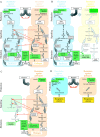Induced systemic resistance (ISR) against pathogens in the context of induced plant defences
- PMID: 12099523
- PMCID: PMC4233886
- DOI: 10.1093/aob/mcf076
Induced systemic resistance (ISR) against pathogens in the context of induced plant defences
Abstract
Induced systemic resistance (ISR) of plants against pathogens is a widespread phenomenon that has been intensively investigated with respect to the underlying signalling pathways as well as to its potential use in plant protection. Elicited by a local infection, plants respond with a salicylic-dependent signalling cascade that leads to the systemic expression of a broad spectrum and long-lasting disease resistance that is efficient against fungi, bacteria and viruses. Changes in cell wall composition, de novo production of pathogenesis-related-proteins such as chitinases and glucanases, and synthesis of phytoalexins are associated with resistance, although further defensive compounds are likely to exist but remain to be identified. In this Botanical Briefing we focus on interactions between ISR and induced resistance against herbivores that is mediated by jasmonic acid as a central signalling molecule. While many studies report cross-resistance, others have found trade-offs, i.e. inhibition of one resistance pathway by the other. Here we propose a framework that explains many of the thus far contradictory results. We regard elicitation separately from signalling and from production, i.e. the synthesis of defensive compounds. Interactions on all three levels can act independently from each other.
Figures

References
-
- AntoniwJF, Pierpoint WS.1978. The purification and properties of one of the ‘b’ proteins from virus‐infected tobacco plants. Journal of General Virology 39: 343–350.
-
- BaldwinIT, Schmelz EA, Zhang Z‐P.1996. Effects of octadecanoid metabolites and inhibitors on induced nicotine accumulation in Nicotiana sylvestris Journal of Chemical Ecology 22: 61–74. - PubMed
-
- BaldwinIT, Zhang Z‐P, Diab N, Ohnmeiss TE, McCloud ES, Lynds GY, Schmelz EA.1997. Quantification, correlations and manipulation of wound‐induced changes in jasmonic acid and nicotine in Nicotiana sylvestris Planta 201: 397–404.
-
- BenhamouN.1996. Elicitor‐induced plant defence pathways. Trends in Plant Science 1: 233–240.
-
- BennettRN, Wallsgrove RM.1994. Tansley Review No. 72: secondary metabolites in plant defence mechanisms. New Phytologist 127: 617–633. - PubMed
Publication types
MeSH terms
Substances
LinkOut - more resources
Full Text Sources
Other Literature Sources

